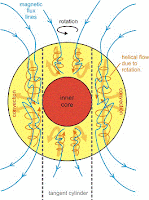 |
| Generation of magnetic field |
Truth be told, it's pretty simple to harvest a boatload of information about the physical properties of iron from Wikipedia, which is probably exactly what Uy did. For the most part, the factoids she scraped from whatever reference are accurate; it's the manner in which she strung them together that caused chuckles in the staff meeting where we choose our nominees. We wondered at her strange turns of phrase, verbiage that reveals that she simply didn't understand what she was trying to say. For instance, Karize told us that,
"Some of the properties of iron include having a strong resistance to high temperatures, being a malleable and ductile material, and being an excellent conductor for electricity and heat."
While we agree that iron is "an excellent conductor," we have no earthly idea what "strong resistance" to anything means in reference to physical properties; and we can say with some confidence that iron is not generally thought of as "malleable and ductile" – some of its alloys, yes, but elemental iron? Karize clearly did not understand the meaning of those two terms. So, Uy's very first paragraph is already questionable. More evidence that she's scientifically ignorant follows closely, in sentences like,
"In terms of appearance, the iron has properties such as a grayish color, luster or shine, and general hardness."
Duh: in addition to being pretty much the same thing, luster and shine are not described as "grayish." As for "general hardness"? We give up... Our house grammarian choked on his coffee when he read that,
"...its density is around 7.87g/cm-3 [sic], making it eight times denser [sic] than water..."
...which is far less accurate than "eight times as dense"; not to mention the quite strange construction of "cm-3," which seems to have no meaning whatsoever. When describing atomic chemistry, Uy proclaimed that,
"Iron, as a solid element, may have particles that are compactly pressed against each other, but these particles have the ability to either slide over and under other particles or spread out in very high temperatures."
We imagine she was trying to differentiate between solid and molten iron, but we honestly have no idea where Karize expected to find gaseous iron. In a star going nova, perhaps? We note that she got some of her bullshit from an ornamental iron vendor's blog. Duh. Another clue that Uy was well outside that J-school comfort zone was the pronouncement that,
"It also takes a significant amount of energy, 340 kJ/mol -1 [sic] to be exact, to transform iron into its gaseous phase and evaporate."
First, she used a weird exponent again ("kJ/mol -1"), and second, Karize did not seem to understand that "transform.. into its gaseous phase" and "evaporate" mean the same damned thing. She also made the bizarre claim that,
"A very unique property of iron is its ability to generate a strong magnetic field around it, which explains why Earth has a magnetic field, as the planet’s core is very abundant in molten iron..."
...which suggests that Uy thinks the mere presence of iron is sufficient to generate a magnetic field (it's not), as well as overlooking the fact that Earth's core consists of solid nickel-iron within a layer of molten nickel iron; it's believed that circulation within the molten layer generates electric currents; and solid iron inside a moving electric field forms an electromagnet.
All this from a scientific illiterate who never once mentioned iron alloys, even though she attempted to assign various alloys' physical properties to iron in general. Sheesh. Once again (for the sixth time, to be accurate), this J-school grad has demonstrated her scientific illiteracy; and, for the sixth time, we find ourselves naming Uy our Dumbass of the Day. We wish she'd stop it...
SI - PHYSICS
No comments:
Post a Comment